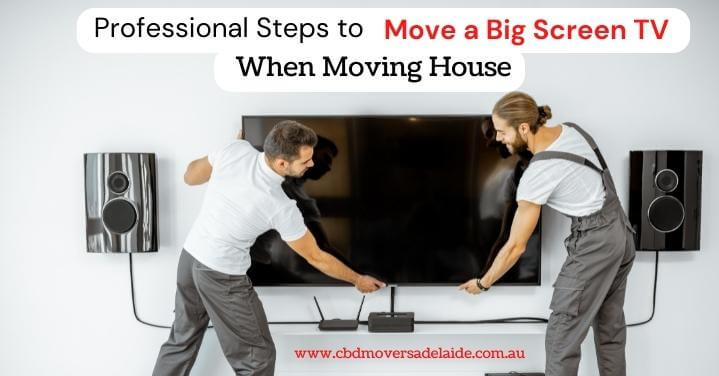A TV is a constant source of entertainment even in the tedious and long hours of packing. This is probably why moving a big screen TV is often left as the last task. Moreover, it may seem an easy-breezy task to pack it.
On the contrary packing, flat-screen TVs are a bit complicated and confusing. People usually come to us asking how to pack a big screen TV for moving. Whether to lay it down or shift it in an upright position?
Are you wondering how to move a big screen TV? To help you we have compiled a few steps to pack your fragile nature TV.
These steps are applicable if you are replacing your old TV or moving house across the city.
1. Use the Original TV Box
Have you ever come across someone who keeps the original packaging for practically all technological devices? That person has probably relocated more than once and is aware that the package the item came in is the best one available. Repack the big screen TV in its original box if you can.
Nevertheless, it is preferable to purchase a big-screen TV moving box-specific alternative carton rather than repack the item in the original one without the properly shaped foam and cardboard supports.
Although covering it in newspaper or bubble wrap can cause harm to the screen during the move, College Muscle Movers advises at least wrapping it in a soft blanket and enclosing the blanket in bubble wrap if you have no other option. We recommend you use the original TV box with Styrofoam for an airtight barrier between the TV and the box.
But most people don’t have the original packaging as they find it hard to store the box.
While other packing materials are too old to handle the TV. In such situations, you need to buy a big screen TV moving box.
The original packaging is made keeping the shipping factor in mind. You can also use sleeves to form a barrier between packing material and screen. Some other options available for you are:
a) Choose a box that has an extra space of three inches when you keep the TV inside it.
b) You can use a comforter and moving blankets to pack the TV. They create space and provide padding between the screen and box. Make sure to pick a blanket without buttons and zippers or else it might scratch your screen.
c) Some companies sell wide and slim boxes to carry flat-screen TVs
2. Things You Need to Move Your LED
Plasma, OLED, and LCD TV screens are incredibly delicate. Even anything as simple as pushing your finger too firmly (which is easy to do while you’re handling a big object) might cause harm to them. For this reason, you must shield your TV’s screen before moving it. Now the question is how to move big screen TV?
A foam cover most likely came with your original box. You can get a flat-screen TV cover at your neighborhood hardware or shipping supply store if you don’t already have one. As instructed by the manufacturer, slide it over the screen. As an alternative, you may pad the screen with bubble wrap.
- Flat Screen TV Box
- Packing Tape
- Twist-tie
- Plastic Baggie
- Packing Paper
- Foam Wrap
- Plastic Wrap
- Foam Corner Pieces or Styrofoam
3. Unplug Accessories and Cords
It is always better to unplug cords in an organized manner and not leave this task to TV movers near me. This makes it easy to keep a tab of the cables.
a) Dust off the TV to work in a clean area
b) Label the cord with masking tape and marker
c) Store Cord in a zip-lock bag
4. Use a Blanket to Wrap the TV Screen
You need a blanket to protect your screen from scratches. Here are some ways to know how to pack a big screen TV for moving to do this.
a) Wrap a blanket using a bungee cord or rope
b) You can use plastic wrap or a plastic protective sleeve made for moving
c) Use packing paper with painter’s tape
5. Know-How to Keep Your TV inside the Moving Vehicle
Make sure to maintain the flat screen upright once you’ve decided how to move a big screen TV in a car. Because flat-screen versions are weight balanced, there won’t be adequate internal support if you lay one flat. This can expose the screen to breaking or edge distortion along with the vibrations in the automobile or moving truck. You should only pack the TV so that it can ride upright, whether you’re driving a rented truck or a car.
You must think about the size of your car while planning how to move a 65-inch TV. A TV that size cannot be safely transported in the back seat or trunk of a compact car or sedan. Moving your TV in a moving truck will be preferable if your car is small.
Put the TV upright in the back seat of the car if you’re transporting it there. To minimize the movement of the TV, fill in any empty area with additional boxes or wrapped moving blankets. Check the rearview mirror while seated in the driver’s seat, then make any necessary adjustments to ensure that your field of vision is unimpeded.
The TV will stay upright and won’t be smashed by any load shifts if you load it between two other flat, upright, and solid objects when loading it aboard a rental moving truck.
The TV should be supported and cushioned throughout the journey if you can create a space next to your mattress and another piece of furniture, such as the back of your sofa or a large chair. To add more padding, place movable blankets all around the television.
Keep your TV in an upright position and elevated in the moving truck. You should place other items around the TV to eliminate the risk of it moving around.
a) Keep your TV between sturdy furniture like a mattress and a sofa
b) In case you can’t find the spot then keep it against a wall
c) A secure TV with a bungee cord by placing one at the top section and the other along with the base.
d) Keep the screen of the TV away from the wall
6. Unpacking with Utmost Care
There are certain things you need to keep in mind after the TV has arrived at your new destination. First thing first, unbox the TV as soon as it arrives.
a) Ask at least two people to move the screen out of the box.
b) Make sure your TV has adjusted to room temperature before turning it on.
c) Check if the TV stands are sturdy and large to place the TV.
d) Let the TV stand for a few hours and come to room temperature before you attempt to reconnect the cables and power it up.
e) If you intend to wall mount the TV, leave it upright in the packing box until you have installed the wall mount.
TVs are an expensive electronic investment. Make sure to take time to pack and move it safely. And don’t forget to clear space to avoid tripping when lifting the box. Last and not least, make sure your box isn’t missing any parts like foam padding. You can also hire professional removalists for hassle-free moving.
7. Work in a Team or Pairs
With a few exceptions, large-screen televisions are often lighter than older models. Older models can occasionally be huge, heavy, and platform-equipped. Don’t try to move your TV by yourself, regardless of how heavy or light it is, that is one of the major pieces of advice on moving a big screen TV while moving house.
With a heavy set, assistance is required. Another issue with lightweight big-screen televisions is that they are brittle. The second pair of hands helps prevent awkward catches, tipping over, and the worst possible scenario of all drops.
8. Keep the TV Centered
You’ve probably heard that because flat-screen TVs can be laid flat, they are simpler to move. That might be accurate in some cases. But simply avoid doing it to be safe. According to Opposing Views: Science, LCD TVs should never be placed flat. The screen’s edges may droop due to gravity, and the delicate glass panels and grid that hold the crystals may crack under pressure.
Consider the positioning of the TV. It is least likely to sustain damage near the bottom of the set, where the support is located. Additionally, anything that unintentionally falls on a big-screen television when it is on its back could shatter the screen.
9. The TV box with Tape and Labels
It’s time to tape the box shut once it has been adequately cushioned. Use packing tape to secure the box, and make careful to reinforce the seams. Label your box “fragile” and “do not lay flat” in large letters on each side with a permanent marker. This last step ensures that your neighborhood movers handle your box properly.
10. Advice for Packing a TV
a) Don’t wait until the last minute to pack the TV or other associated electronics. Important components could be misplaced in the turmoil, making it more challenging to reconnect to your new house.
b) When transporting the TV and its components, avoid moisture. If you’re worried, you might include silica gel packs to keep the moving box’s interior moist.
c) Before you disassemble the system to pack it, quickly take pictures of the video connectors. By using this, you can ensure that you are reconnecting properly.
d) Including remotes, pack devices, and all associated parts together, and properly identify them.
e) Even though many gadget user manuals are currently accessible online, others are still not, particularly if your item is older than a few years or is not manufactured by a well-known company.
Hope you will find these tips helpful.
All the best for your moving day!









